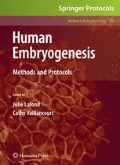Abstract
Human and animal cell lines are important laboratory tools that can be used for studying a variety of cell functions. Some cell lines are blocked at a certain step of maturation and can be used in order to study the mechanisms involved in cell maturation. Because such cell lines can be differentiated toward a more mature-like phenotype after the addition of agents, they can replace primary cells in large screening experiments preventing daily isolation. The human promyelocytic HL-60 leukemia cell line is an attractive model for studying the events which occur in myeloid cells. Interestingly, these cells can be differentiated toward monocytes, macrophages, or granulocytes as described in the present chapter.
Access this chapter
Tax calculation will be finalised at checkout
Purchases are for personal use only
References
Auwerx, J. (1991) The human leukemia cell line, THP-1: a multifacetted model for the study of monocyte-macrophage differentiation. Experientia 47, 22–31.
Collins, S. J. (1987) The HL-60 promyelocytic leukemia cell line: proliferation, differentiation, and cellular oncogene expression. Blood 70, 1233–1244.
Koeffler, H. P. (1983) Induction of differentiation of human acute myelogenous leukemia cells: therapeutic implications. Blood 62, 709–721.
Collins, S. J., R. C. Gallo, and R. E. Gallagher. (1977) Continuous growth and differentiation of human myeloid leukaemic cells in suspension culture. Nature 270, 347–349.
Collins, S. J., F. W. Ruscetti, R. E. Gallagher, and R. C. Gallo. (1978) Terminal differentiation of human promyelocytic leukemia cells induced by dimethyl sulfoxide and other polar compounds. Proc Natl Acad Sci USA 75, 2458–2462.
Fischkoff, S. A., A. Pollak, G. J. Gleich, J. R. Testa, S. Misawa, and T. J. Reber. (1984) Eosinophilic differentiation of the human promyelocytic leukemia cell line, HL-60. J Exp Med 160, 179–196.
Miyaura, C., E. Abe, T. Kuribayashi, H. Tanaka, K. Konno, Y. Nishii, and T. Suda. (1981) 1 alpha, 25-Dihydroxyvitamin D3 induces differentiation of human myeloid leukemia cells. Biochem Biophys Res Commun 102, 937–943.
Tanaka, H., E. Abe, C. Miyaura, T. Kuribayashi, K. Konno, Y. Nishii, and T. Suda. (1982) 1 alpha, 25-Dihydroxycholecalciferol and a human myeloid leukaemia cell line (HL-60). Biochem J 204, 713–719.
McCarthy, D. M., J. F. San Miguel, H. C. Freake, P. M. Green, H. Zola, D. Catovsky, and J. M. Goldman. (1983) 1,25-dihydroxyvitamin D3 inhibits proliferation of human promyelocytic leukaemia (HL60) cells and induces monocyte-macrophage differentiation in HL60 and normal human bone marrow cells. Leuk Res 7, 51–55.
Tanaka, H., E. Abe, C. Miyaura, Y. Shiina, and T. Suda. (1983) 1 alpha, 25-dihydroxyvitamin D3 induces differentiation of human promyelocytic leukemia cells (HL-60) into monocyte-macrophages, but not into granulocytes. Biochem Biophys Res Commun 117, 86–92.
Rovera, G., D. Santoli, and C. Damsky. (1979) Human promyelocytic leukemia cells in culture differentiate into macrophage-like cells when treated with a phorbol diester. Proc Natl Acad Sci USA 76, 2779– 2783.
Rovera, G., T. G. O’Brien, and L. Diamond. (1979) Induction of differentiation in human promyelocytic leukemia cells by tumor promoters. Science 204, 868–870.
Pelletier, M., A. Bouchard, and D. Girard. (2004) In vivo and in vitro roles of IL-21 in inflammation. J Immunol 173, 7521–7530.
Pelletier, M., A. Savoie, and D. Girard. (2000) Activation of human neutrophils by the air pollutant sodium sulfite (Na(2)SO(3)): comparison with immature promyelocytic HL-60 and DMSO-differentiated HL-60 cells reveals that Na(2)SO(3) is a neutrophil but not a HL-60 cell agonist. Clin Immunol 96, 131–139.
Author information
Authors and Affiliations
Editor information
Editors and Affiliations
Rights and permissions
Copyright information
© 2009 Humana Press, a part of Springer Science+Business Media, LLC
About this protocol
Cite this protocol
Ennaciri, J., Girard, D. (2009). Immune System: Maturation of Myeloid Cells. In: Vaillancourt, C., Lafond, J. (eds) Human Embryogenesis. Methods in Molecular Biology, vol 550. Humana Press. https://doi.org/10.1007/978-1-60327-009-0_12
Download citation
DOI: https://doi.org/10.1007/978-1-60327-009-0_12
Published:
Publisher Name: Humana Press
Print ISBN: 978-1-60327-008-3
Online ISBN: 978-1-60327-009-0
eBook Packages: Springer Protocols

